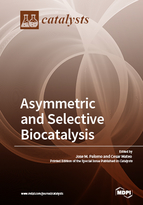Asymmetric and Selective Biocatalysis
A special issue of Catalysts (ISSN 2073-4344). This special issue belongs to the section "Biocatalysis".
Deadline for manuscript submissions: closed (31 October 2016) | Viewed by 69839
Special Issue Editors
Interests: nanotechnology; nanobiotechnology; nanocatalysis; biocatalysis; protein chemistry; medicinal chemistry; chemical biology; chemical technology; organic chemistry
Special Issues, Collections and Topics in MDPI journals
Interests: biocatalysis; CO2 transformation; redox processes; cofactor regeneration; enzyme immobilization
Special Issues, Collections and Topics in MDPI journals
Special Issue Information
Dear Colleagues,
The preparation of pure chiral building blocks with the desired configuration is extremely important in different areas, especially in the production of pharmaceuticals. In this way, biocatalysts (cells, enzymes, catalytic antibodies, or ribozymes) represent the best alternative to the chemical processes because of the high regio- and enantio-selectivity towards different substrates at very mild conditions.
This Special Issue will be focused on innovative and novel research in “Asymmetric and Selective Biotransformations”.
Prof. Dr. Jose M. Palomo
Prof. Dr. Cesar Mateo
Guest Editors
Manuscript Submission Information
Manuscripts should be submitted online at www.mdpi.com by registering and logging in to this website. Once you are registered, click here to go to the submission form. Manuscripts can be submitted until the deadline. All submissions that pass pre-check are peer-reviewed. Accepted papers will be published continuously in the journal (as soon as accepted) and will be listed together on the special issue website. Research articles, review articles as well as short communications are invited. For planned papers, a title and short abstract (about 100 words) can be sent to the Editorial Office for announcement on this website.
Submitted manuscripts should not have been published previously, nor be under consideration for publication elsewhere (except conference proceedings papers). All manuscripts are thoroughly refereed through a single-blind peer-review process. A guide for authors and other relevant information for submission of manuscripts is available on the Instructions for Authors page. Catalysts is an international peer-reviewed open access monthly journal published by MDPI.
Please visit the Instructions for Authors page before submitting a manuscript. The Article Processing Charge (APC) for publication in this open access journal is 2700 CHF (Swiss Francs). Submitted papers should be well formatted and use good English. Authors may use MDPI's English editing service prior to publication or during author revisions.
Keywords
- kinetic resolutions of racemic mixtures
- asymmetric synthesis
- oxidations
- reductions
- C-C bonding formation
- regioselectivity
- enantioselectivity







